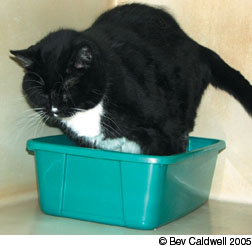Why in the world are there so many types of litter boxes available? Does box style really matter? Most cat owners purchase litter boxes that are inexpensive and readily available. Sometimes, designer litter boxes become attractive options – maybe some people figure, if we have to deal with the mess, at least we should have an aesthetically pleasing container.
It appears that, for the majority of housecats, any container will be accepted as a litter box as long as it holds a sandy substrate. On the other hand, some cats seem to have strong opinions about the minimum basic requirements for a litter box.
What will be the first clue that your cat is of the opinionated variety? A fussy cat is likely to convey his dissatisfaction with his litter box by eliminating very close to the box. He may hop into the box, quickly hop out, and eliminate just several inches away. Some cats actually stand in the box but somehow manage to make the deposit just outside the box.

252
When the urine and stool are very close to the box, check the box, check the box, check the box. Of course, check the cat, too. A physical examination is always in order. Be sure there is no infection and no source of pain. Once the health clearance is completed, the first question should be: What could be wrong with the litter box?
The most basic litter boxes are rectangular in shape. They come in a few somewhat standard sizes. And this should be the first problem to consider. Cats are not all that standardized: They vary in size and shape. Even beyond the obvious growth from kittenhood to adulthood, an adult cat may change both his size and shape as he matures. A litter box that was once adequate may no longer do. And a so-called jumbo box may not be as jumbo as some cats.
So watch your cat the next time he visits the litter box. Does your cat still fit comfortably? Can he posture the way he needs to in order to both urinate and defecate without being cramped? If he is a shy cat, try sitting out of the way to observe his behavior. If he can barely balance to complete his business, then the box may no longer be comfortable.
Aging Cats Have Changing Needs
Besides changing size and shape, cats change in their flexibility as they age, particularly if they have any degenerative joint conditions. So the cat that scrunched into his litter box for 10 years may no longer be able to assume that same posture. Instead, he may miss the box or choose a location that does not present such a challenge.
Similarly, a hood may make it more difficult for a large cat to posture adequately. A hooded box can create a tight squeeze. When selecting a box, consider also that the flaps fitted over the entrance may not swing freely. Some openings are just too small for a cat to squeeze through comfortably.
Beyond the basic boxes, be they open or hooded, extra large or standard, boxes are available in assorted other shapes. Circular and wedge-shaped boxes are available. These styles are designed to be space savers. They fit into corners or under round tables. But remember: If they save us floor space, then they also cut back on the space available to the cat.
Even more upscale are boxes that can be incorporated into our own furnishings. There are ottoman-style boxes, table-style boxes and boxes with tops that serve as planters. While these alternative box types may suit a cat that really prefers to eliminate in the main living space, for some cats, the non-traditional styles may be confusing. Most cats have been conditioned to seek a rectangular box filled with sand.
In summary, it is not likely that one box will fit all. For many cats, we are free to choose a box to our liking. However, should there be any unacceptable elimination whatsoever, consider three things: Can your cat find the box, recognize the box and fit into the box?
If not, start thinking like a cat. Examine the situation as your cat would, and provide the solution your cat needs. If you have a passion for a particular box style, it may be possible to develop a systematic strategy to condition your cat to cooperate with your preference. On the other hand, considering all the pleasure our cats provide, maybe making a litter box concession is not so much for us to give in return.



